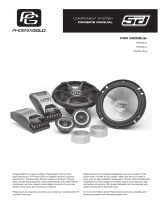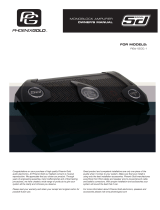Page is loading ...

RSD and Aftermarket Friction
Frequently Asked Questions
One of your top priorities as a fleet or owner-operator is maintaining the safe operation of your vehicles. Bendix, as
always, remains committed to helping you do just that. With the recent implementation of the final phase of the
Reduced Stopping Distance (RSD) mandate, selecting the proper replacement friction is more critical than ever.
Choosing replacement friction for RSD trucks can be confusing, especially in light of conflicting information in the
marketplace. Think of Bendix as your resource on these important issues. To help you better understand what’s at
stake in vehicle maintenance decisions, we share these commonly asked questions.
Why was the RSD mandate implemented?
The National Highway Traffic Safety Administration (NHTSA) implemented the RSD mandate with the goal of
improving highway safety, and reducing injuries, fatalities, and property damages resulting from accidents. The
regulation requires vehicles to stop in 250 feet from 60 mph.
Estimated annual benefits of RSD*
o 227 lives saved
o 300 serious injuries avoided
o $169 million in property damages avoided
*Source: Federal Motor Carrier Safety Administration (FMCSA)
How do I know if RSD affects the truck(s) I am maintaining?
The regulations affect tractors built after August 2011 (for Phase One) and August 2013 (for Phase Two). There is
no requirement to retrofit older vehicles.
RSD Phase One: Aug. 1, 2011, affects 6 x 4 tractors below 59,600 lbs. GVWR
RSD Phase Two: Aug. 1, 2013, affects all other tractor applications, including 4 x 2s
Is there any legal obligation to maintain RSD after service? If not, why would I choose to?
Although there is currently no legal requirement to maintain RSD compliance, your choice of aftermarket
friction can have a significant impact on your vehicle’s stopping distance performance and safety. If you
reline with noncompliant friction (friction material that is not RSD certified), you may not maintain the stopping
distance performance your vehicle is capable of. In the event of a crash, you may expose yourself to potential
fatalities and property damages, as well as higher insurance rates and a negative impact to your CSA scores.
Review this chart to see how friction selection impacts stopping distance.
Source: Bendix testing

Will RSD-certified friction increase my operating costs?
No. While it’s true that RSD-certified friction carries a higher initial price tag, it’s important to factor in what you may
save by avoiding the potential pitfalls of relining with noncompliant friction (friction material that is not RSD-
certified). This protection and peace of mind far outweigh the cost of RSD friction.
In addition, to address concerns regarding additional costs, we developed Bendix
®
Advanced BA202R, a cost-
effective solution to maintain RSD compliance. The BA202R material is an RSD-certified replacement friction that is
comparable in cost to previous generation OE materials. Like all Bendix RSD-certified linings, BA202R comes with
a letter of certification from Bendix, so you can be confident it will give you the performance you expect.
Since RSD trucks already have larger brakes, does it matter which replacement lining I select?
Yes. Bigger brakes are only half the battle. During an emergency stop, heat is generated faster than it can be
dissipated through the drum. RSD-certified friction has a superior ability to handle high temperatures while
maintaining torque. Prior generation OE and most aftermarket friction are simply not engineered to handle these
conditions.
How do I know if a shoe is RSD compliant? Does it have a different edge code?
Unfortunately, RSD-certified friction does not have a special edge code. Because of this, it’s critical that you
always do two things to ensure you’re getting what you need for your vehicle:
First, look for labeling on the
shoe that indicates whether
the shoe is RSD compliant.
Bendix has added a label on our
RSD shoes to make technicians
aware they are servicing an RSD
brake, but this is not currently
done throughout the industry.
Next, ask your supplier for an
RSD-certified friction that’s
appropriate for your vehicle.
Take caution in simply taking a
supplier’s word on this issue.
Ensure you are getting the
performance you expect – ask for
evidence of RSD certification.
For a list of Bendix RSD-certified friction,
see our RSD Friction Certification letter
(BW7537) in the online Literature Center
at foundationbrakes.com.
Does the FMSI indicate that the friction is RSD-certified?
No. The FMSIs used on RSD-compliant trucks are available in the marketplace with a wide variety of frictions;
some are compliant, some are not. To maintain RSD compliance, you must get the proper friction on the proper
FMSI. For a friction material to be certified as RSD compliant, it must not only be dynamometer certified to
FMVSS 121, it must also pass the newly mandated vehicle test. Both elements must be in place for RSD
compliance – there is not a choice of one or the other.

Bendix Spicer Foundation Brake LLC • 901 Cleveland Street • Elyria, OH 44035 • www.foundationbrakes.com • 1- (866) 610-9709
BW7551 ©2014 Bendix Spicer Foundation Brake • All Rights Reserved
If it says 20K on the friction, it must be OK to put it on any 20K axle, including an RSD truck, correct?
Again, FMVSS 121 is not sufficient to certify a friction as RSD compliant. There are two different methods to
officially certify friction as RSD compliant:
1. Certification as part of an OE truck build, or
2. Approval by a certified vehicle test provider
To eliminate any doubts about appropriate friction selection, we encourage you to ask your supplier for evidence of
this compliance.
Can I reline with Bendix RSD friction and maintain compliance if my RSD truck is not equipped with Bendix
brakes?
That’s a question we are asked quite often. With the wide variety of vehicle platforms available in the marketplace,
it would be impossible to test every one. Bendix has tested a number of representative vehicles, and we believe
that when identical vehicle parameters and brake sizes are in place, using Bendix
®
brand RSD friction materials on
non-Bendix brakes may enable you to maintain RSD compliance.
If it’s torque that is needed for RSD compliance, can’t I just run higher torque rated materials?
We do not recommend this practice. Just because a material has a high torque does not mean it is designed to
handle the high heat generated during emergency braking conditions. Plus, you may experience undesirable side
effects such as brake noise, rapid wear, and poor system balance.
In addition to selecting RSD-certified linings, what else do I need to be concerned about when selecting
replacement friction?
RSD friction cannot perform as engineered unless it is paired with a quality brake shoe. When selecting aftermarket
friction for your RSD-equipped truck, make sure you also get a brake shoe that’s built to deliver the performance
you need. Keep these factors in mind when selecting a
brake shoe supplier. :
Structural integrity: RSD shoes must be able to
handle the required torque. Shoes that have
been relined too many times may be fatigued or
corroded.
Coining: If the shoe is not coined, it may have
poor geometry. This may result in a weak or
small contact patch of friction to the drum. This
can create excessive heat and fade, resulting in
longer stopping distance.
Your brake shoe supplier should be able to provide you
with information on the brake shoe production process.
Still have questions? Want more information?
It can be difficult to separate fact from fiction when selecting replacement friction for your RSD truck. For assistance
in understanding RSD and selecting the appropriate friction to maintain RSD compliance, count on the experts at
Bendix. Talk to your Bendix account manager or call the Bendix Tech Team at 1-800-AIR-BRAKE.
Visit www.foundationbrakes.com for additional information and resources regarding wheel-end solutions
from Bendix Spicer Foundation Brake.
Log in and learn from the best 24/7/365. Visit www.brake-school.com.
/


